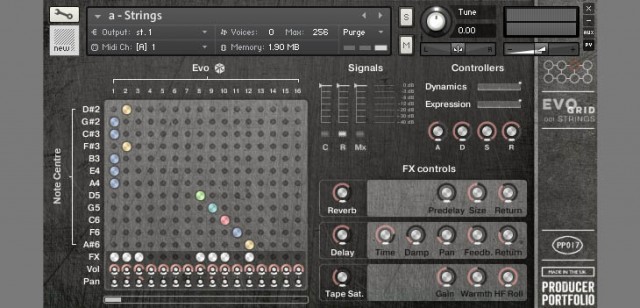
Spitfire Audio has introduced Evo Grid 001 – a new virtual instrument that features long, evolving orchestral strings.
Here’s a video intro:
Here’s what they have to say about Evo Grid 001:
Spitfire went about recording 48 different and very long Evos. Not just tense, mysterious and frightening Evos as with Scary Strings. But also intensely beautiful, tender and moving.
Recorded across 12 intervals, and arranged on a 12 x 48 grid the true genius of this library lies in its interface.
With a GUI Inspired by the EMS VCS3 you can instantly select (or peg) what evo sits on each of the 12 key ranges. This gives you literally an almost infinite number of personalised configurations. Toggle your pegs around, or hit “Randomise”, replay the MIDI and no cue will ever sound the same twice!
The pièce de résistance here though is the ability to play ultra minimal music whilst holding your audience captive with the ever changing kaleidoscope of progressive string techniques.
Whilst playing the material orchestrated by Ben Foskett, we couldn’t stop ourselves from creating an additional 5 grids of awesome warped, saturated and totally The Evo Grid 001 library is available for the introductory price of £134 GBP until March 2nd, 2015 (RRP £179 GBP). Requires a full version of Kontakt 4 or 5.
Evo Grid 001 is available now from the Spitfire Audio site for £134, through March 2nd, RRP £179 thereafter.

Hey demo guys how about the first minute of video show off the music, then talk about it.
It seams everyone want to describe it, but you have to wait 3-5 minutes before any sound, that might lead to people wondering off and never get to find out what they miss
does this mean it does not play in free Kontact plater, you have do buy Kontact bloatware for £350?
From their site “Requires a full version of Kontakt 4 or 5 to run.”
A tricky rompler, but still just another rompler. There’s probably a way to program this kind of complexity into VAST in a Kurzweil, which would mean this is not anything new.
The presets here don’t appear to overtly map to particular sound groups, so I’m thinking it would be difficult to aim for a kind of a sound let alone a particular sound amid the infinity of pin placements. There are other soft synthesizers, particularly some free ones such as H. G. Fortune’s AlienSpaceWeaver and ScapesWizard, HGSounds SoundScaper, and Sonic Charge’s Synplant that can produce immense varieties of weird and familiar sounds if you are looking for inspiration, and are not dependent on having the full version of Kontakt. How tweakable and finely controllable this synth is will determine on whether it is less a toy and more a useful tool. How long do you sit there moving pins about muttering, “That’s not right… that’s not right… that’s not quite right…” until you throw up your hands and decide to hire a string quartet to just do it right and get the job out of the way?